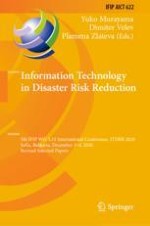2021 | Buch
Information Technology in Disaster Risk Reduction
5th IFIP WG 5.15 International Conference, ITDRR 2020, Sofia, Bulgaria, December 3–4, 2020, Revised Selected Papers
herausgegeben von: Prof. Dr. Yuko Murayama, Prof. Dr. Dimiter Velev, Plamena Zlateva
Verlag: Springer International Publishing
Buchreihe : IFIP Advances in Information and Communication Technology
